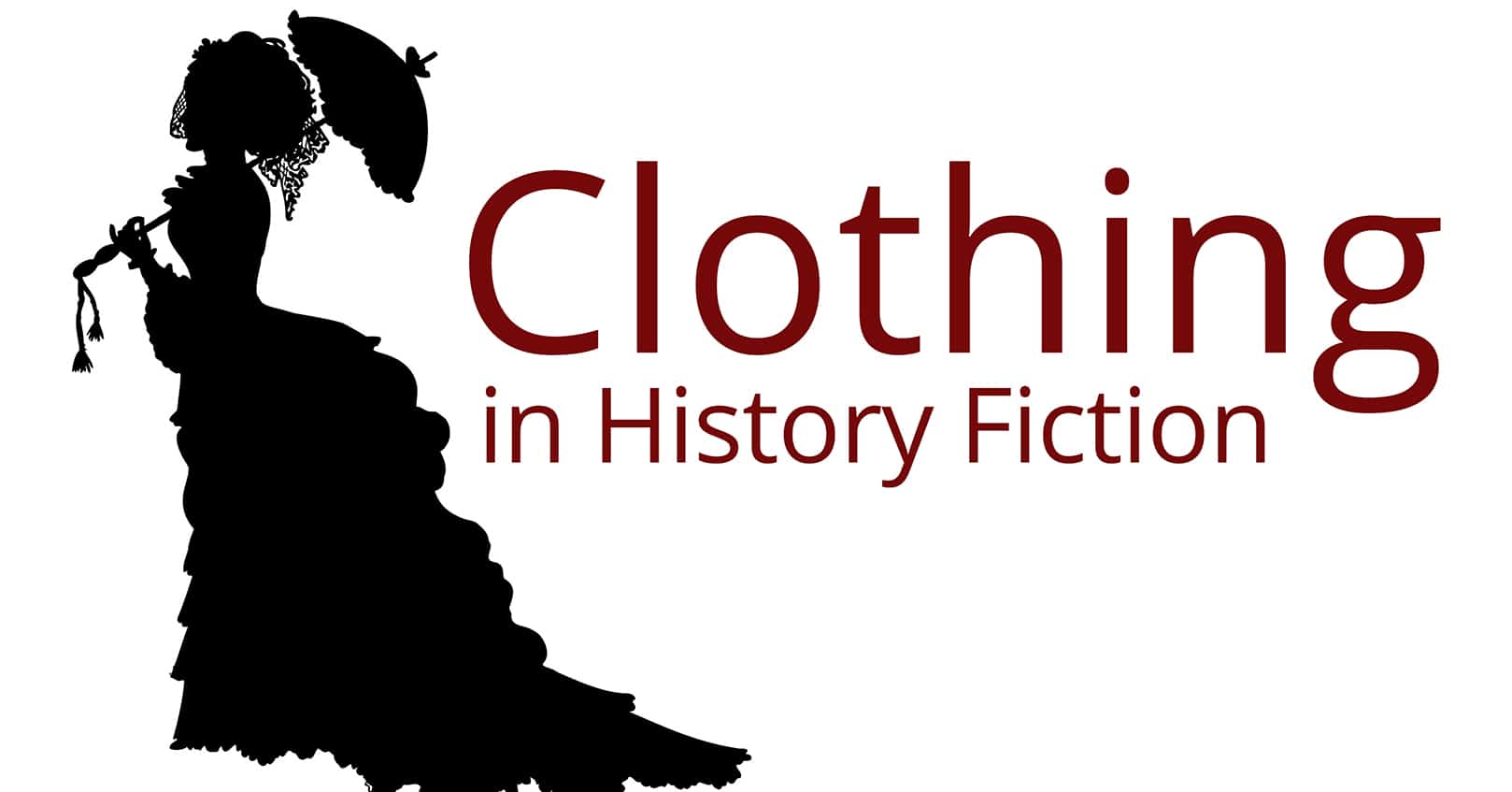
Clothing. It’s why people love historical or fantasy dramas on TV, and it’s part of the fun of reading historical fiction. Hoopskirts and corsets sound so sexy and romantic. Just so long as you don’t read anything said by the actresses who did not enjoy wearing them all day (proving that they were NOT well-fitted corsets . . .)!
When I had to pick the years for my first novel, part of the choice was because of the clothing. Sure, I love hoopskirts, too, but . . . bustle dresses!! When I decided to write My Dearest Miss Fairfax, I did not get any choices in the matter. Jane Austen’s Emma is set firmly during the Regency, so the fashions I get to describe are set for me.
It always makes me die inside, sometimes more than a little, when I read historical fiction, or watch movies/television, and the creative powers clearly did not care enough to do their homework. I’m sorry, to me, it’s not “artistic interpretation of what clothing from (fill in the blank) was like.” It’s just lazy. I have to give Bridgerton a pass: at least the screen adaptation is set in an alternative universe where people of color have a lot more power and control over their lives than the vast majority do in actual history. In a way, it was an imperative to do something fanastical with the costuming. This is not real history, it should look like not real history.
The history of clothing is, on its own, a lot like an epic family saga, full of rebellion and conformity and new innovations. Just like any other history, the truth is far more compelling than any Hollywood invention to “improve” it.
So let’s just talk about clothing in Western civilization! I will start in the 1700s, because, well, just like my historical fiction novel, I just have to commit to a starting place.
The courts of Europe have been setting the fashions for a couple hundred years. Clothing is a way to designate your social rank. When you “dress to impress,” the most important person to impress is the king. Think about who is on the throne in France: Louis fourteen, fifteen and sixteen! Think about their wives and mistresses: Madame de Pompadour, Marie Antoinette. There is almost a race to see just how excessive clothing can get. How much gold embroidery can human beings fit on their bodies? How tall can women have their hair piled above their actual heads before they topple over? (True story: women had to ride on the floor of the carriage when they went to a ball.) How much wider than the door can panniers get?
So the end of the eighteenth century/beginning of the nineteenth sees an act of rebellion every bit as bumptious as the 1960s, when women were burning their bras and both genders were growing out their hair.
The heavy, embroidered fabrics were jettisoned. Men’s coats had been slimming down over the 1700s; now they were a solid wool, not covered in gold bullion embroidery. There was an exciting new fabric, just being imported to Western markets, called muslin, and women were wearing almost nothing but white by 1800. It was very lightweight and did not have the structural integrity to be made into the elaborate dresses of the 1700s. So the silhouette for female clothing collapsed into something that looks like a nightgown to us.
Imagine the scandal! Walking out in public and people could see what a female body actually looks like! If that’s not explicit enough, when women went to a ball, they would mist down their thin muslin dresses with water. French women barely covered their breasts at all. There are portraits of Napoleon Bonaparte’s sister Pauline that make it very clear: she is NOT wearing undergarments. So going to a ball around 1800 was a lot like going to an oversized wet t-shirt contest. No wonder dancing was extremely popular with both genders!
So, now there is something new to be reactionary about. Now ladies get to rebel against having to go out in public practically naked. By 1815, women have decided always dressing in white is pretty boring. Portraits and fashion plates are now showing women wearing red, and green, and blue. Men’s fashions don’t show any really radical changes quite yet. I’m sure the guys were disappointed about the end of the wet t-shirt contests. I’m also thinking dancing was never < emphasis >quite as popular again.
Another facet of the story of fashion that is hugely important at this point in the narrative is the industrial revolution. The textile industry is one of the first to be changed by mechanization. Fabrics and lace and trims are now much cheaper. Ever notice how Jane Austen novels keep talking about shopping? That’s because it’s THE new national pastime. Men are every bit as excited about going to buy gloves as women are to buy ribbon. The street directory from Weymouth in 1816 that I used for my novel showed me an absolute mania for shopping: this small town was filled with shops specializing in bonnets and dry goods—and even smuggled silks from France!
The industrial revolution continued to shape the story of clothing. Cheaper fabrics contributes to the re-expansion of women’s skirts. The narrow skirts of 1800 get wider . . . and wider . . . and wider . . . until you get the pinnacle with the afore-mentioned hoopskirts of the 1860s. But it wasn’t just court women wearing those coveted big skirts. Laura Ingalls Wilder describes in Farmer Boy how the wife and daughters of a well-to-do farmer in New York had to pause and tug when they walked through a door, because their skirts were wider than the doorframe.
Meanwhile the men go through a completely different revolution. “The Great Renunciation” actually goes back to the 1700s, but it’s really taking hold in the early 1800s. George Washington still wore a wig and breeches: but by the time Thomas Jefferson is in office in 1801, adornment on male clothing, wigs, and breeches that require expensive tailoring are all considered elitist and anti-democratic. French men made the same sacrifice during the French Revolution for pretty much the same reasons. In England, Beau Brummel declared ornate clothes vulgar, and George IV and all the court slavishly followed his advice. We call them “influencers” today. The black frock coat becomes the regulation garment for Victorian men, the “sack suit” becomes an easy daywear ensemble—and then men’s clothing gets stuck pretty much until the 1960s.
Back to the women. I love the next phase of the story. Hoopskirts deflate, the big part gets pushed to the back, and we get my favorite era: bustle dresses! These are some of the most over-the-top dresses humans have ever imagined—because the industrial revolution has made it into everyday homes! Every woman knows that it takes, say, 40 hours to make a dress (I have no idea, honestly. But just remember, those giant hoopskirt dresses were completely sewn BY HAND). But now that she has her own sewing machine, the base of the dress was completed in 8 hours. So, what’s a girl to do? Spend the rest of the 32 hours using that new ruffler foot attachment (ain’t technology grand?) and add ruffles to the skirt! Make an overskirt to put over that, and cover it with ruffles, too! Put tiny ruffles around the neckline. Put great big pleated ruffles at the elbow. Women have access to cheaper laces and fabrics, they have their own power tools, and there is an explosion of creativity.
But, of course, women also have limited OTHER outlets in life: they can’t get jobs, they can’t vote, they get to stay home and make babies and raise the children. It is not unreasonable to suggest that the reason women’s clothing changes almost yearly while men’s almost don’t change in over 100 years is because they’re bored and have little else to engage their minds.
By the end of the 1880s, the bustle is gone. Instead of giant skirts to make your waist look small, corsets get tighter under dresses that emphasize an hourglass figure. Some women cheat and get ribs removed so that they can really get that tiny waist in proportion to hips and bust. (Undergarments are a whole story unto themselves! Maybe some other time . . .) Trains dissolve away over the years—why would anyone want to drag a whole lot of extra fabric around behind you? Sure, it keeps the floors clean . . . but, ew.
Women in the 1890s are an active lot. They ride bicycles and elude watchful parents who used to have such a tight grip on their children’s mating rituals. They play tennis. “Bachelor girls” leave home and go get jobs in the city. There is a demand for more practical clothing: sportswear for women is more than just the scandalous bloomers that are basically very full trousers. Shorter A-line skirts are in vogue that make it much easier to play tennis…or walk. Think of the “Gibson girl” that Charles Dana Gibson brings us in 1898. She’s an active sort of woman.
The first half of the 20th century is a story of pragmatism—less fabric, more practical—laced with excess. And with some amusing contrasts to the previous generation. Women wore shackles around their ankles in the nineteen-teens. This was not some symbolic thing as a metaphor for their inability to vote. The skirts were so narrow, you would rip your skirt just trying to move normally. Go figure. The shorter skirts of the 1920s solves the problem of ripping your skirt. Wars influence clothing: after the deprivations of the wartime 1940s, is it any surprise skirts exploded into fullness in the 1950s when there was access to fabric again?
The 1960s social revolution is what happens when there’s a baby boom. Have more than one or two kids, then the youth outnumber the older folks, and stuff is going to change. Of course the kids expressed themselves through their clothing. Just wear whatever is going to annoy your parents. Men aren’t supposed to wear color? We’ll wear tye-dye. Women are supposed to wear bras? Burn them.
Clothing is a never-ending reflection of human nature and will never fail to be an engrossing story.

















Georgette Heyer in Arabella (1949) gives a master class in fashion…
The first and most pressing consideration was the getting together of a wardrobe suitable for a young lady hopeful of making a successful début. Earnest perusal of the fashion journals had cast Arabella into a mood of despair, but Mama took a more cheerful view of the matter. She commanded the houseboy to summon the ubiquitous Joseph Eccles up to the Parsonage, and desired the pair of them to fetch down from one of the attics two formidable trunks. Joseph, who had been employed by the Vicar since the first year of his marriage as the farm-hand, considered himself the mainstay of the establishment, and was only too ready to oblige the ladies; and he lingered in the dressing-room, proffering counsel and encouragement in the broadest of Yorkshire dialects until kindly but firmly dismissed.
A pleasing aroma of camphor pervaded the air as soon as the lids were raised from the trunks, and the removal of a covering of silver paper disclosed treasures innumerable. The trunks contained the finery which Mama had worn (she said) when she was just such a giddy puss as Arabella. When she had married Papa she had had no occasion for such fripperies, but she had not been able to bring herself to give them away, and had packed them up and well-nigh forgotten all about them.
Three ecstatic gasps shuddered on the air as three rapt young ladies dropped down on their knees beside the trunks, and prepared to rummage to their hearts’ content.
There were unimagined delights in the trunks: curled ostrich plumes of various colours; branches of artificial flowers; an ermine tippet (alas, turned sadly yellow with age, but it would serve to trim Sophy’s old pelisse!); a loo-mask; a whole package of finest thread-lace; a tiffany cloak, which set Margaret peacocking round the room; several ells of ribbon of a shade which Mama said was called in her young days opéra brulé, and quite the rage; scarves of gauze, lace, and blonde, spangled and plain; a box containing intriguing knots of ribbon, whose names Mama could not quite remember, though she rather thought that that pale blue bunch was A Sign of Hope, and the pink bow A Sigh of Venus; point-lace tuckers,-and lappet-heads; a feather muff; innumerable fans; sashes; a scarlet-flowered damask mantua petticoat—what a figure Mama must have looked in it!—and a velvet cloak, miraculously lined with sable, which had been a wedding-gift to Mama, but which she had scarcely worn, “because, my loves, it was finer than anything your aunt possessed, and, after all, she was the Squire’s wife, and dreadfully inclined to take a pet, so that I always took care never to give her the least cause to be offended. But it is a beautiful fur, and will make a muff for Arabella, besides trimming a pelisse!’’
It was fortunate that Mama was an indulgent parent, and so very fond of a joke, for the trunks contained, besides these treasures, such old-fashioned garments that the three Misses Tallant were obliged to laugh. Fashions had changed a great deal since Mama was a girl, and to a generation accustomed to high-waisted gowns of muslin and crape, with little puff-sleeves, and demure flounces round the hems, the stiff, voluminous silks and brocades Mama had worn, with their elaborate undergowns, and their pads, and their wired bodices, seemed not only archaic, but very ugly too. What was this funny jacket, with all the whalebone? A Caraco? Gracious! And this striped thing, for all the world like a dressing-gown? A lustring sack—well, it was certainly very like a sack, to be sure! Did Mama wear it in company? What was in this elegant box? Poudre la Maréchale! But did Mama then powder her hair, like the picture of Grandmama Tallant, up at the Hall? Oh, not quite like that! A gray powder? Oh, Mama, no! and you without a gray hair to your head! How did you dress it? Not cut at all? Curls to the waist at the back? And all those rolls and puffs over the ears! How could Mama have had the patience to do it? So odd as it must have looked, too!
But Mama, turning over half-forgotten dresses, grew quite sentimental, remembering that she had been wearing this very gown of green Italian taffeta, over a petticoat of satin, soupir d’étouffe (unaccountably missing), when she had first met Papa; remembering the pretty compliment paid to her by that rejected baronet when he had seen her in the white silk waist Sophia was holding up (it had had a book-muslin train, and there should be somewhere a pink silk coat, very smart, which she had worn with it); remembering how shocked her Mama had been when she had seen that rose-coloured Indian muslin underwear which Eliza—your Aunt Eliza, my loves—had brought her from London.
The girls did not know where to look when Mama sighed over a cherry-striped gown, and said how pretty it had been, for really it was quite hideous, and it made them feel almost uncomfortable to think of Mama’s being seen abroad in such a garment. It was beyond laughter, so they sat respectfully silent, and were profoundly relieved when suddenly she shook off this unaccustomed mood, and smiled, and said in her own brisk way: “Well, I daresay you think I must have looked like a dowd, but I assure you I did not! However, none of these brocades is of any use to Arabella, so we will put them up again. But that straw-coloured satin will do famously for a ball-dress, and we may trim it with some of the point-lace.”